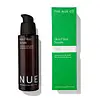What's inside
What's inside
 Key Ingredients
Key Ingredients

 Benefits
Benefits

 Concerns
Concerns

No concerns
 Ingredients Side-by-side
Ingredients Side-by-side

Water
Skin ConditioningAloe Barbadensis Leaf Juice
Skin ConditioningNiacinamide
SmoothingZinc PCA
HumectantAzelaic Acid
BufferingPropanediol
SolventPotassium Azeloyl Diglycinate
Skin ConditioningKojic Acid
AntioxidantHyaluronic Acid
HumectantSodium Ascorbyl Phosphate
AntioxidantGlycyrrhiza Glabra Root Extract
BleachingGlutathione
Allantoin
Skin ConditioningPhenylethyl Resorcinol
AntioxidantSqualane
EmollientAscorbyl Palmitate
AntioxidantArbutin
AntioxidantPunica Granatum Extract
AstringentResveratrol
AntioxidantCitrus Aurantium Dulcis Oil
MaskingFragaria Ananassa Fruit Extract
Skin ConditioningSodium Metabisulfite
AntioxidantPhenoxyethanol
PreservativeEthylhexylglycerin
Skin ConditioningXanthan Gum
EmulsifyingWater, Aloe Barbadensis Leaf Juice, Niacinamide, Zinc PCA, Azelaic Acid, Propanediol, Potassium Azeloyl Diglycinate, Kojic Acid, Hyaluronic Acid, Sodium Ascorbyl Phosphate, Glycyrrhiza Glabra Root Extract, Glutathione, Allantoin, Phenylethyl Resorcinol, Squalane, Ascorbyl Palmitate, Arbutin, Punica Granatum Extract, Resveratrol, Citrus Aurantium Dulcis Oil, Fragaria Ananassa Fruit Extract, Sodium Metabisulfite, Phenoxyethanol, Ethylhexylglycerin, Xanthan Gum
Water
Skin ConditioningGlycerin
HumectantIsoamyl Laurate
EmollientHeptyl Glucoside
Galactoarabinan
Sclerotium Gum
Emulsion StabilisingGlycolic Acid
BufferingLactic Acid
BufferingVaccinium Myrtillus Fruit Extract
Skin ConditioningBakuchiol
AntimicrobialSodium Hydroxide
BufferingPhenoxyethanol
PreservativeMaltodextrin
AbsorbentCaffeine
Skin ConditioningSaccharum Officinarum Extract
MoisturisingIsoamyl Cocoate
Dipotassium Glycyrrhizate
HumectantZinc PCA
HumectantCitrus Aurantium Dulcis Fruit Extract
MaskingCitrus Limon Fruit Extract
MaskingEthylhexylglycerin
Skin ConditioningAcer Saccharum Extract
Skin ConditioningLeuconostoc/Radish Root Ferment Filtrate
AntimicrobialTerminalia Ferdinandiana Fruit Extract
AntioxidantTrisodium Ethylenediamine Disuccinate
Hyaluronic Acid
HumectantNephelium Lappaceum Peel Extract
Skin ConditioningHeptanol
PerfumingPinus Strobus Bark Extract
Skin ConditioningWater, Glycerin, Isoamyl Laurate, Heptyl Glucoside, Galactoarabinan, Sclerotium Gum, Glycolic Acid, Lactic Acid, Vaccinium Myrtillus Fruit Extract, Bakuchiol, Sodium Hydroxide, Phenoxyethanol, Maltodextrin, Caffeine, Saccharum Officinarum Extract, Isoamyl Cocoate, Dipotassium Glycyrrhizate, Zinc PCA, Citrus Aurantium Dulcis Fruit Extract, Citrus Limon Fruit Extract, Ethylhexylglycerin, Acer Saccharum Extract, Leuconostoc/Radish Root Ferment Filtrate, Terminalia Ferdinandiana Fruit Extract, Trisodium Ethylenediamine Disuccinate, Hyaluronic Acid, Nephelium Lappaceum Peel Extract, Heptanol, Pinus Strobus Bark Extract
Ingredients Explained
These ingredients are found in both products.
Ingredients higher up in an ingredient list are typically present in a larger amount.
Ethylhexylglycerin (we can't pronounce this either) is commonly used as a preservative and skin softener. It is derived from glyceryl.
You might see Ethylhexylglycerin often paired with other preservatives such as phenoxyethanol. Ethylhexylglycerin has been found to increase the effectiveness of these other preservatives.
Hyaluronic acid is naturally found in healthy skin. It is a humectant, meaning it draws moisture to your skin.
This ingredient helps hydrate, soothe, and protect the skin.
What makes hyaluronic acid so hydrating? It has the capacity to bind or hold large amounts of water.
Fun fact: It is already naturally found in our bodies, such as the fluids of our eyes and our joints.
Studies find this ingredient to have anti-inflammatory and anti-microbial properties. This can help speed up wound-healing.
Hyaluronic acid can be irritating if the molecule has a low-molecular weight, or if the molecules are small.
One study found low-molecular weight hyaluronic acid to be pro-inflammatory, meaning some people may experience irritation. This is because our bodies use hyaluronic acid in the wound-healing process to signal to our bodies, via irritation, that something needs healing.
The same study found high-molecular weight hyaluronic acid to be anti-inflammatory.
These are some other common types of Hyaluronic Acid:
Learn more about Hyaluronic AcidPhenoxyethanol is a preservative that has germicide, antimicrobial, and aromatic properties. Studies show that phenoxyethanol can prevent microbial growth. By itself, it has a scent that is similar to that of a rose.
It's often used in formulations along with Caprylyl Glycol to preserve the shelf life of products.
Water. It's the most common cosmetic ingredient of all. You'll usually see it at the top of ingredient lists, meaning that it makes up the largest part of the product.
So why is it so popular? Water most often acts as a solvent - this means that it helps dissolve other ingredients into the formulation.
You'll also recognize water as that liquid we all need to stay alive. If you see this, drink a glass of water. Stay hydrated!
Learn more about WaterZinc PCA (or "zinc salt") differs slightly from zinc itself. PCA stands for pyrrolidone carboxylic acid. However, Zinc PCA comes from zinc.
It can help reduce redness, regulate sebum, and promote the general healing process of the skin.
Zinc PCA tends to be especially useful for those with oily, acne-prone skin. It's certainly an ingredient worth trying out!
Learn more about Zinc PCA